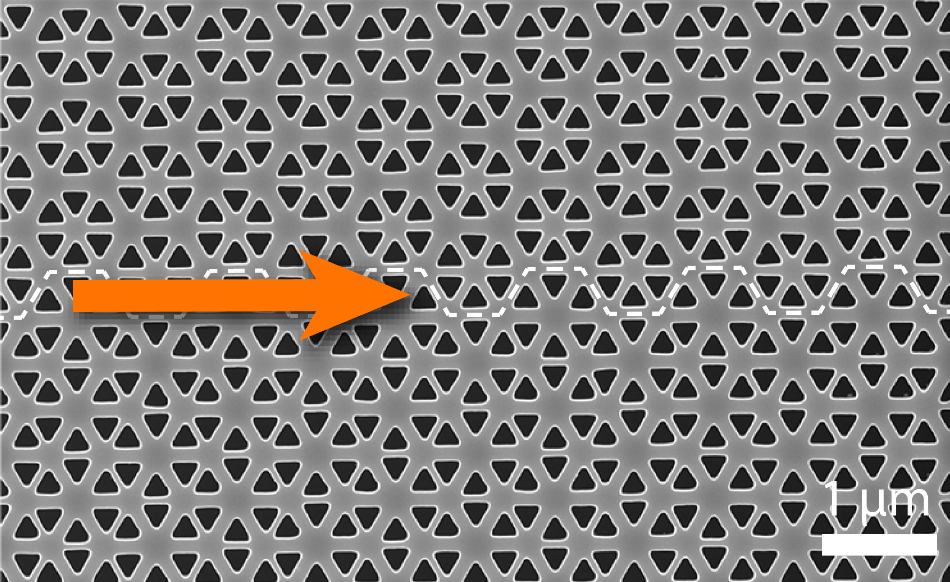Mar 9 2020
Scientists from AMOLF and the Delft University of Technology (TU Delft) have witnessed the propagation of light in a unique material without undergoing any reflections. The material is a photonic crystal including two parts, each of which has a somewhat different pattern of perforations.
 Electron microscopy image of topological photonic crystals in a perforated slab of silicon. The top and bottom crystal structures differ slightly; along the boundary between two parts (dotted line) light can be guided. The disparate mathematical description (topology) of the light fields in the two crystals prescribes that their boundary has to conduct light; that conduction is thus “topologically protected.” Image Credit: AMOLF.
Electron microscopy image of topological photonic crystals in a perforated slab of silicon. The top and bottom crystal structures differ slightly; along the boundary between two parts (dotted line) light can be guided. The disparate mathematical description (topology) of the light fields in the two crystals prescribes that their boundary has to conduct light; that conduction is thus “topologically protected.” Image Credit: AMOLF.
Light is capable of uniquely propagating along the boundary between these two parts: it is “topologically protected” and does not get reflected at imperfections. Despite the fact that a sharp corner is formed by the boundary, the light follows it without any difficulty.
According to Ewold Verhagen, group leader at AMOLF, “For the first time, we have seen these fascinating light waves move at the technologically relevant scale of nanophotonics.” The study results were recently reported in the Science Advances journal on March 6th, 2020.
Topological Insulators: Special Electronics
Together with his collaborator Kobus Kuipers from TU Delft, Ewold Verhagen took a cue from electronic materials, where topological insulators form a novel family of materials with excellent behavior. While a majority of the materials are either conductive for electrons or not (which makes them an insulator), topological insulators feature a unique form of conduction.
The inside of a topological insulator does not allow electron propagation, but along the edge, electrons can move freely. Importantly, the conduction is ‘topologically protected’; the electrons are not impacted by disorder or imperfections that would typically reflect them. So the conduction is profoundly robust.
Ewold Verhagen, Group Leader, AMOLF
Translation to photonics
In the last 10 years, researchers have made efforts to discover this behavior for the conduction of light as well.
We really wanted to accomplish topological protection of light propagation at the nanoscale and thus open the door to guiding light on optical chips without it being hindered by scattering at imperfections and sharp corners.
Ewold Verhagen, Group Leader, AMOLF
The research group made use of two-dimensional photonic crystals with two hole patterns that were somewhat different. The “edge” that allows light conduction is the interface between the hole patterns.
According to Kuipers, “Light conduction at the edge is possible because the mathematical description of light in these photonic crystals can be described by specific shapes, or more accurately by topology.”
The two distinct hole patterns of the photonic crystals have different topologies, and this is exactly the feature that allows the conduction of light at the boundary, analogous to electrons in topological insulators. Since both the hole patterns have a locked topology, it is not feasible to revoke the light conduction, thus it is “topologically protected.”
Imaging Topological Light
The scientists could somehow image the propagation of light using a microscope and observed that its behavior was as predicted. Furthermore, the team viewed the mathematical description or topology in the observed light.
For these light waves the polarization of light rotates in a certain direction, analogous to the spin of electrons in topological insulators. The spinning direction of light determines the direction in which this light propagates. Because polarization cannot easily change, the light wave can even flow around sharp corners without reflecting or getting scattered, as would happen in a regular waveguide.
Kobus Kuipers, Researcher, TU Delft
Technological Relevance
The group was the first to directly view the propagation of topologically protected light on the technologically applicable scale of nanophotonic chips. According to Verhagen, the application prospects can be increased by intentionally using light and silicon chips of an analogous wavelength as used in telecommunication.
According to the researchers, “We are now going to investigate if there are any practical or fundamental boundaries to topological protection and which functionalities on an optical chip we could improve with these principles.”
They continued saying, “The first thing we are thinking of is to make the integrated light sources on a photonic chip more reliable. This is important in view of energy-efficient data processing or ‘green ICT’. Also, to efficiently transfer small packages of quantum information, the topological protection of light can be useful.”